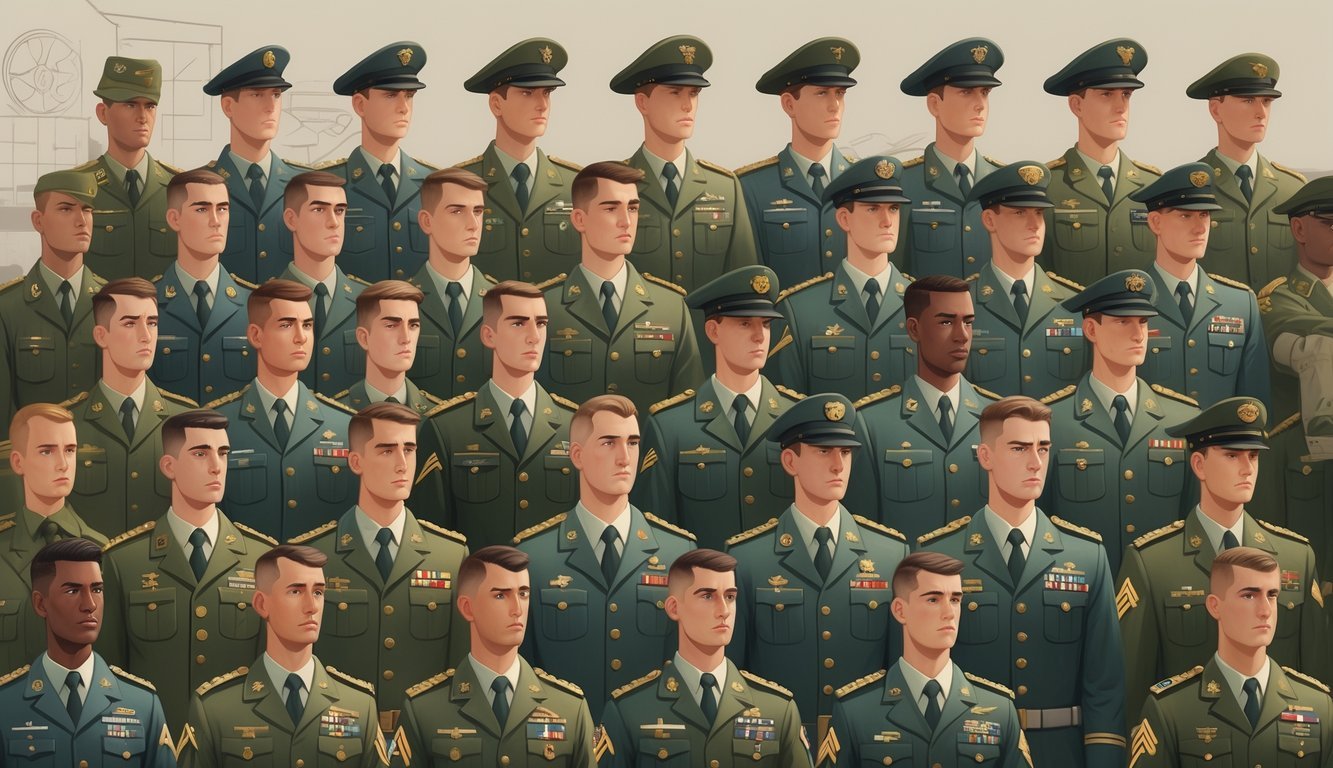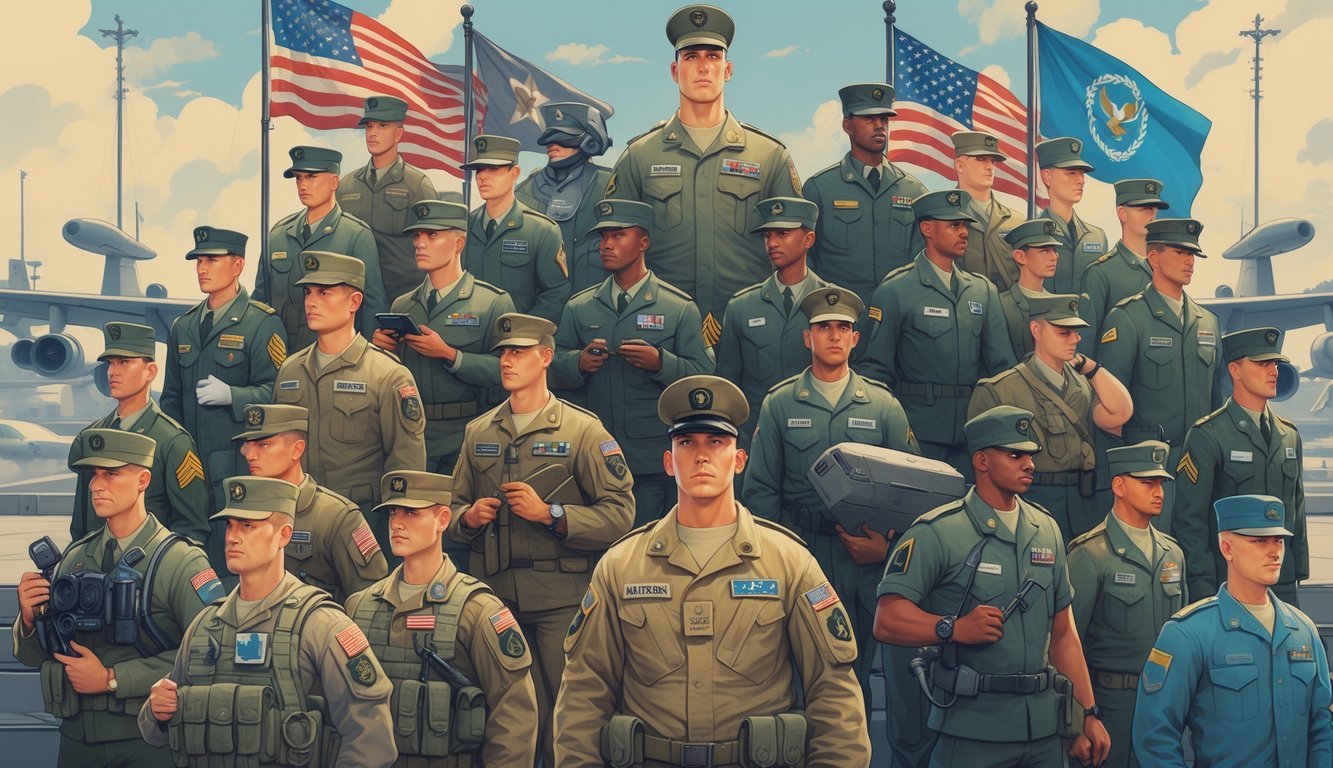PsychNewsDaily Publishers
100 Summit Drive
Burlington, MA, 01803
Telephone: (320) 349-2484
PsychNewsDaily Publishers
100 Summit Drive
Burlington, MA, 01803
Telephone: (320) 349-2484
The U.S. Army has a structured rank system for enlisted soldiers, warrant officers, and commissioned officers, each indicating levels of responsibility and leadership.

Ever wondered how the U.S. Army sorts out its ranks or what jobs you could actually do there? This guide lays it all out in a way that’s easy to get. The Army sticks to a clear system of ranks, each one marking a jump in responsibility or leadership.
If you know the ranks and the jobs that go with them, you can picture how an Army career might grow and shift.
Ranks start with enlisted folks—think Privates and Corporals—and run all the way up to officers like Lieutenants and Colonels. Each step up means new duties and more chances to lead.
Army jobs? There are tons. Some are all about combat, others are technical, and plenty focus on support.
If you’re thinking of joining up or just mapping out your career, getting a grip on Army ranks and jobs gives you a real sense of what’s out there. We’ll break down the basics so you can figure out what fits.

Ranks in the Army show what a soldier does and how much responsibility they have. You’ll spot different groups of ranks, from brand-new enlisted soldiers to the top brass.
Insignia make it easy to tell who’s who at a glance.
The Army splits ranks into three main groups: Enlisted Soldiers, Warrant Officers, and Commissioned Officers.
Enlisted soldiers handle most of the hands-on work and lead at the squad or team level. Warrant officers act as technical experts and advisors. Commissioned officers lead bigger groups and plan missions.
Each rank uses a pay grade—E-1 to E-9 for enlisted, W-1 to W-5 for warrant officers, and O-1 to O-10 for officers. These grades show not just your pay, but your place in the pecking order. As you move up, your responsibilities grow.
You start as a Private (PV1)—that’s the first stop. Next, you hit Private Second Class (PV2) and then Private First Class (PFC).
After that, you can become a Specialist (SPC) or a Corporal (CPL). Corporal’s the first real leadership spot.
Sergeant ranks kick off with Sergeant (SGT), then go up through Staff Sergeant (SSG), Sergeant First Class (SFC), Master Sergeant (MSG), First Sergeant (1SG), Sergeant Major (SGM), Command Sergeant Major (CSM), and finally Sergeant Major of the Army (SMA).
Each rank comes with its own insignia, so people know right away where you stand.
Warrant officers specialize in advanced skills. You’ll start at Warrant Officer 1 (WO1).
With more experience, you can move up to Chief Warrant Officer 2 (CW2) and all the way to Chief Warrant Officer 5 (CW5).
They fill the gap between enlisted and commissioned officers. Usually, they take on technical jobs—like flying helicopters or managing equipment. Their insignia looks different too, marking them as warrant officers.
Commissioned officers run the show, from small units to huge commands. You begin as a Second Lieutenant (O-1), then become a First Lieutenant (O-2) and a Captain (O-3).
Move up and you reach Major (O-4), Lieutenant Colonel (O-5), and Colonel (O-6).
The generals sit at the top, starting with Brigadier General (O-7) up to General (O-10). The very highest is General of the Army, a five-star rank they only use in wartime.
You’ll see officer insignia on shoulders or collars—it’s hard to miss.

Joining the Army opens up a surprising number of job choices. You can pick roles on the front lines or go for jobs that work behind the scenes.
There are also leadership tracks if that’s more your thing.
If you want to be where the action is, combat arms jobs might call your name. Infantry, armor, cavalry, and field artillery all fit here.
You’ll learn weapons, tactics, and survival skills. These jobs demand serious teamwork and discipline.
Special Forces take it even further. They handle tough missions and need advanced skills—think airborne operations and more. If you want to push your limits, Special Forces could be the challenge you’re looking for.
Military Police play a combat role too, keeping law and order on bases and in combat zones. These jobs need a strong sense of justice and plenty of discipline. They help keep everyone safe and missions running smoothly.
Not every Army job is about fighting. Support and specialist roles keep everything running.
You might work in medical care, mechanical repair, transportation, legal services, or even journalism. These jobs ask for attention to detail and a solid work ethic.
In these roles, you use your skills to help soldiers and commanders get things done. Medics treat injuries, mechanics keep the vehicles rolling—everyone plays a part.
Support jobs matter whether you’re on active duty, in the Army Reserve, or the National Guard.
These roles also give you room to grow your career. Technical know-how and problem-solving matter a lot here. Your work keeps the Army moving toward its goals.
Leadership’s a big deal in military life. Whether you’re enlisted or an officer, you’ll get chances to lead teams and units.
Officers start as second lieutenants and train to plan and manage soldiers.
Drill sergeants take on a special leadership role. They train new Soldiers in Army values like discipline, teamwork, and courage.
You learn how to motivate people and stick to what the Army stands for.
Army leadership builds you up for big responsibilities in brigades and battalions. You get real experience managing people and missions.
These skills come in handy long after your Army days. Growing as a leader means growing as a person, not just a soldier.

Here are answers to some common Army questions—stuff like rank order, pay, and jobs you might actually do.
Enlisted ranks start at Private and go up to Sergeant Major. Officer ranks begin with Second Lieutenant and reach all the way to General of the Army, which is a five-star rank.
Each rank lines up with a pay grade—E-1 for a new Private, O-3 for a Captain, and so on. Higher grades mean more responsibility and a higher spot in the hierarchy.
Enlisted ranks include Private (E-1), Private Second Class (E-2), Private First Class (E-3), Specialist or Corporal (E-4), Sergeant (E-5), Staff Sergeant (E-6), Sergeant First Class (E-7), Master Sergeant or First Sergeant (E-8), and Sergeant Major (E-9).
Most folks reach Private First Class (E-3) or Specialist (E-4) after about two years, depending on their job and how they perform.
You could be a Combat Engineer, Infantryman, Medic, or Tank Crewman. There are also roles like Cyber Operations Specialist or Intelligence Analyst.
General of the Army holds the top spot—a five-star rank.
The military usually awards it only during wartime or in rare cases as a special honor.